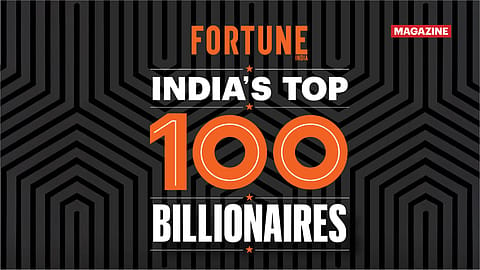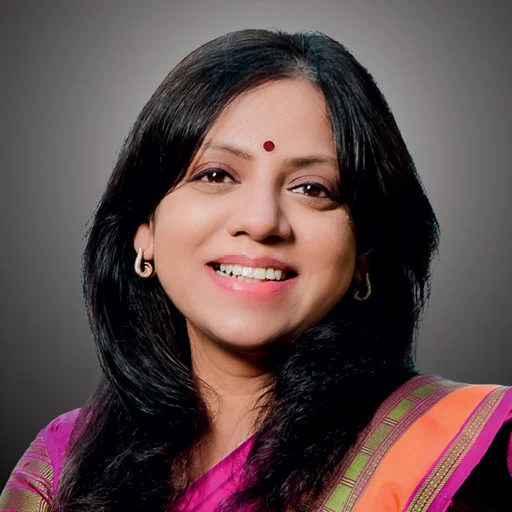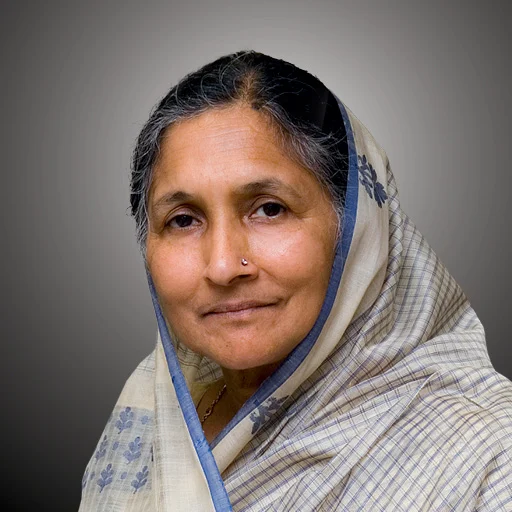India's Top 100 Billionaires: Wealth, power, and the $1-trillion club
Amid market swings, fresh listings, and legacy splits, India’s Top 100 billionaires are still painting the town red with a cumulative net worth of ₹87.02 lakh crore.

This story belongs to the Fortune India Magazine August 2025 issue.
WHAT’S THE MOST relevant question to ask a billionaire about wealth?
The answer can vary wildly depending on which corner of the world you’re observing this rarefied cohort from. But one question that holds universal intrigue is this: At what threshold does wealth just become a number?
Though no one has offered a definitive answer, Bill Gates — one of the world’s richest individuals with a net worth of $124 billion — has arguably come the closest. The Microsoft co-founder, in an interaction with students at the University of Washington in 2011, said: “…I can understand wanting to have millions of dollars — there’s a certain freedom, meaningful freedom, that comes with that. But once you get much beyond that, I have to tell you, it’s the same hamburger.”
So, if billionaires, indeed, are chewing on the same patties, instead of simply stacking more patties on the rich list, Fortune India decided to craft its own signature burger.
Beginning this year, Fortune India will spotlight a tightly curated club: India’s Top 100 billionaires — not the entire pool of dollar billionaires. In association with Waterfield Advisors, one of India’s leading wealth advisory firms, we’re choosing depth over sprawl, zooming in on the faces, fortunes, and forces shaping India’s wealth landscape at the very top.
But here’s the twist.
After a blockbuster 2024, when India’s richest breached the trillion-dollar threshold for the first time, 2025 marked a breather. For the first time in three years, the combined net worth of the Top 100 took a knock — slipping from ₹87.54 lakh crore to ₹87.02 lakh crore, a decline of ₹52,023 crore.
More Stories from this Issue
The good news?
India’s Top 100 billionaires are still worth $1.015 trillion, despite a $28-billion slide from the $1.043 trillion in 2024.
The culprit?
A combination of a flat market over the past one year (1.28% rise in the Nifty to 24,855 on July 30, 2025, vs 24,541 on August 16, 2024) and currency drag, with the rupee depreciating 2.10% from 83.96 to 85.76 against the dollar.
(INR CR)
The Top 10
Here’s the big reveal, though. Only 46 individuals saw an increase in their wealth this year, a little more than half of the 88 who saw gains in 2024. The aggregate wealth of these 46 billionaires in 2025 is ₹34.07 lakh crore, with a combined value accretion of ₹6.29 lakh crore. Compare that to 2024, when the wealth of the gainers jumped by a staggering ₹26.60 lakh crore, contributing to an aggregate of over ₹80.29 lakh crore.
The top three slots remained unchanged in 2025, but not without bruises. Mukesh Ambani and Gautam Adani held on to their No. 1 and No. 2 ranks despite sharp erosions in wealth — down ₹1.01 lakh crore and ₹1.29 lakh crore, respectively. The Mistry family (Shapoor, Firoz, and Zahan) stayed steady at No. 3, though their fortune too shrank by ₹42,591 crore.
The big mover of the year is Sunil Mittal, who jumped four spots to No. 4, adding a massive ₹84,134 crore to his net worth on the back of Bharti Airtel’s resounding FY25 performance led by strong revenue growth, improved profitability, and better ARPU figures. Right behind him, Kumar Mangalam Birla also surged four places to break into the Top 10 at No. 9, clocking a ₹44,097-crore rise — powered by the robust performance across the Aditya Birla Group. The Bajaj family (Shekhar, Niraj, Rajiv, and Sanjiv) also inched into the Top 10 at No. 10, adding ₹35,166 crore, driven by strong momentum in financial services and auto. Meanwhile, veterans like Savitri Devi Jindal, Shiv Nadar, and Dilip Shanghvi slipped a notch each despite modest or flat wealth changes — testament to the fierce jostling at the top.
With five of the Top 10 seeing a drop in their net worth and four others sliding in rank, 2025’s leaderboard proves one thing: staying on top is tougher than getting there.
The contrast between 2024 and 2025 is telling: not only did fewer people gain, but the quantum of wealth creation also shrank by over 76%. This underlines the unevenness of the market rebound and the higher concentration of value gains among fewer individuals. Among the Top 100, 19 individuals control over ₹51.31 lakh crore, nearly 59% of the collective fortune.
The remainder 81 account for ₹35.72 lakh crore, with the 100th cut-off at ₹24,283 crore. It’s a telling sign of the rich getting richer, even as India climbs the global GDP ladder — ranked fourth with a GDP of ₹331.03 lakh crore. That means the Top 100 control a little over a fourth (26.29%) of India’s GDP, while the top 19 alone account for nearly 15%.
What really stands out is the scale and spread of the decline. While only 10 names saw wealth erosion in 2024 (amounting to ₹1.34 lakh crore in losses), that number has ballooned to 47 in 2025, with a massive ₹6.22 lakh crore shaved off their combined fortunes. That’s more than 4.6x the decline recorded last year, making 2025 one of the most uneven years in billionaire wealth trajectories. However, the 47 names who lost wealth this year still account for ₹49.26 lakh crore in collective value — more than the total value of all 46 gainers (₹34.07 lakh crore).
No surprise then that despite the macro turmoil and volatility on the Street, some of India’s wealthiest are literally enjoying the chill! Over a call from Iceland, where he is currently holidaying, traditional industry titan Hari Mohan Bangur, MD of Shree Cement, tells Fortune India: “India is facing temporary problems. We don’t have to worry too much. The next 20 years are going to be fantastic,” he says. “With our demography and the aspiration for a better life, the momentum is intact. Even the hiccups will be small. I believe the Indian economy will be at least two-and-a-half times bigger in the next 10 years,” says the 72-year-old, whose family is ranked 29th with a net worth of over ₹70,000 crore.
Bangur, who believes India is unfairly underestimated owing to the lack of discussion around purchasing power parity, adds with a chuckle, “I’m in Europe right now, and I must say our airports are better. Our highways are better. City roads, yes, need work — but overall, we’re building better, living better.”
Concurring with Bangur’s outlook is Soumya Rajan, founder and CEO of Waterfield Advisors, who insists that the current soft patch is “just a blip”. “This is a mark-to-market reality,” she tells Fortune India. “Markets are cyclical, and we’re seeing a temporary slowdown. But wealth creation in India is on a strong footing — the number of ultra-high-net-worth families is expected to double over the next five years. The underlying earnings growth will kick in soon enough.”
A deeper look at the list
But who’s still feasting, and who’s off the menu? That’s where the list gets interesting.
Among the 88 names who have retained their spots in the Top 100, 41 saw an increase in cumulative net worth — ranging from ₹47 crore to ₹84,134 crore, while 47 names saw a decline, with losses ranging from ₹31 crore to ₹1.29 lakh crore. As a result, the cumulative net worth of the 88 fell from ₹82.33 lakh crore in 2024 to ₹81.78 lakh crore this year.
But here’s the churn. Of the 12 new entrants, with a cumulative value of ₹5.23 lakh crore, three names made their debut after public listing of their ventures, and two other significant additions were B. Partha Saradhi Reddy & family of Hetero Labs, valued at ₹35,740 crore, and Ranjan Pai, with a wealth of ₹25,899 crore. Five individuals who weren’t part of the Top 100 last year but made their way in are: A. Krishnamoorthy, Abhay Soi, Devi Prasad Shetty, K.P. Ramasamy, and Yadu Hari Dalmia. Two more names, tagged as “new,” reflect the formal split within the Godrej family, with brothers Adi-Nadir and brother-sister duo Jamshyd Godrej-Smita Godrej Crishna, now listed separately on the list.
The billionaire landscape
India’s billionaire landscape across the five core sectors — diversified, pharma, IT, FMCG, and realty — grew from ₹47.1 lakh crore in 2022 to a peak of ₹64.88 lakh crore in 2024, before softening to ₹61.56 lakh crore in 2025. The number of billionaires remained steady, hovering between 55 and 57.
Diversified businesses continued to dominate with ₹35.3 lakh crore in 2025, though down from last year’s peak. Pharma and FMCG showed resilience, holding steady in value despite macro headwinds. IT billionaire wealth rose consistently before a mild dip this year, while real estate saw the sharpest reversal after a big jump in 2024.
The takeaway? 2025 marks a year of consolidation: fewer gains, more caution, and a return to fundamentals across sectors.
Despite the uneven spread of gains and the creeping anxiety around macro uncertainty, there’s a quiet confidence that runs through India’s billionaire club in 2025. From cement to capital markets, there’s broad belief that the fundamentals are intact, and the future is still up for the taking. For instance, Bangur remains unfazed by the oversupply cloud hanging over the cement industry. “If your hotel is fully booked in the first year, it means you built it too small. The idea is to grow into capacity. In two years, this surplus will be absorbed,” he says.
If cement is a proxy to the India growth story, so is housing and allied infra plays. Balkrishan Goenka, valued at ₹25,989 crore, is happy plugging into the opportunities that the canvas offers. “We are trying to position ourselves as a company that focusses more on the domestic market to mitigate risks and capture this growing opportunity. If India becomes a $10-trillion economy and one of the top three economies globally, the biggest beneficiaries will be companies that supply to the housing sector,” Goenka tells Fortune India. Considering its portfolio of water pipes, PVC pipes, Sintex tanks, towels, curtains, or bath rugs, Welspun has truly meshed itself into India’s growth fabric.
While the future looks bright as ever, in the interim, the changing contours of India’s consumption story and tariff concerns saw private sector capex fall to 9% of GDP in FY25, hitting a three-year low.
But Rajan is optimistic. While she acknowledges the unpredictability of global politics — especially the looming effects of Trump-era tariff shocks — she sees Indian companies as uniquely agile. “The real impact of these tariffs might hit in a few quarters,” she warns. “But Indian corporates are extremely nimble. They’re learning to pivot fast.”
In many ways, Goenka is emblematic of the tremendous sense of self-belief among India’s billionaire cohort. “We are heading towards a $5-trillion economy, and there’s a good chance we will hit $10 trillion in the next five years. Given that, there’s plenty of room for us to look inward,” he says.
So yes, though a few patties were missing this year, India’s billionaires are cooking up fresh recipes to make their burger rich and loaded again.




